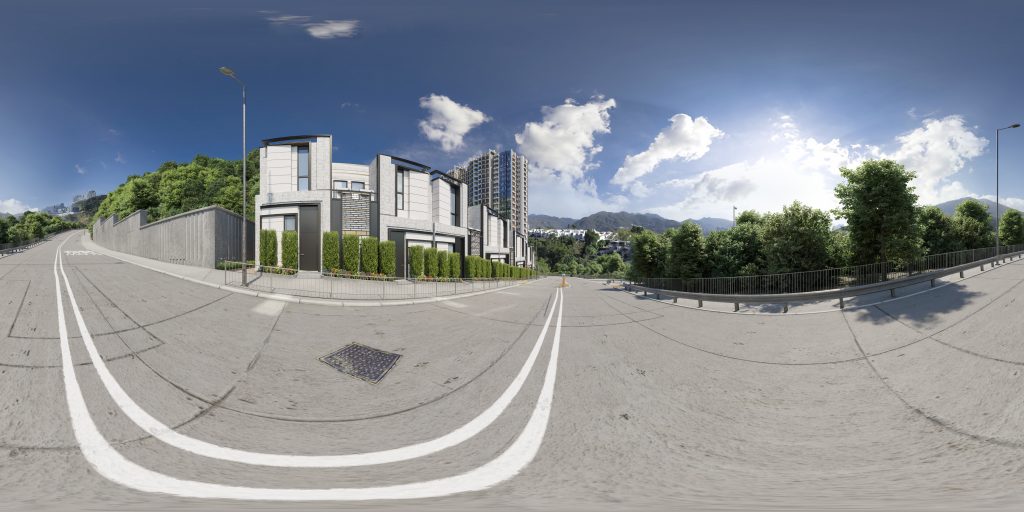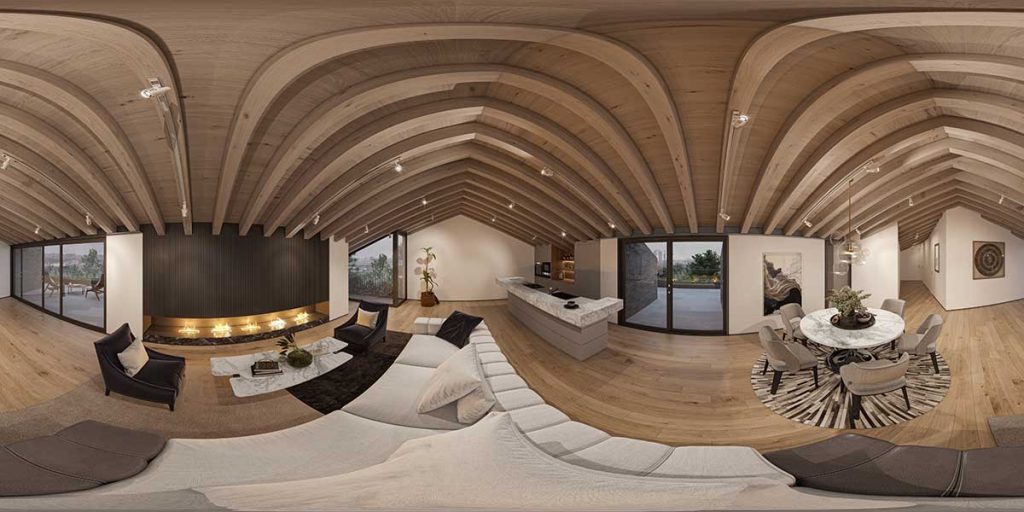The Future of CGI: Virtual Reality, AI and Other Breakthrough Technologies
September 18, 2024
Computer-Generated Imagery (CGI) has become an essential tool in architecture, design, and real estate. It enables professionals to create highly realistic visualizations of buildings, interiors, and landscapes, providing clients with a clear vision of projects before they are physically realized.
The significance of CGI in architecture and real estate
- Enhanced visualization. CGI allows architects and designers to create lifelike models of structures, giving clients a comprehensive understanding of design concepts.
- Accurate representation. With CGI, it’s possible to simulate materials, lighting, and textures, ensuring that the final result matches the design intent.
- Cost-effective design modifications. Changes to a project can be made digitally, saving time and money by avoiding physical prototypes.
- Effective marketing. Real estate developers use CGI to create stunning visual representations of properties, helping potential buyers or investors visualize completed projects.
Staying updated with technological advancements
The evolution of CGI tools and software is critical in architecture and real estate. Staying current with advancements is vital for:
- Producing high-quality visuals. The latest technologies offer enhanced rendering capabilities, providing more photorealistic results.
- Improving client engagement. New interactive and VR capabilities allow clients to explore spaces in real-time, enhancing decision-making processes.
- Exploring sustainable solutions. With advanced CGI tools, architects can visualize the environmental impact of materials and designs, aiding in the creation of eco-friendly projects.


Open +
The evolution of CGI in architecture, design, and real estate
Historical perspective on CGI development:
- 1960s–1970s: early beginnings. The foundation of CGI in architecture began with simple wireframe models, allowing architects to create basic digital structures. These early models laid the groundwork for future advancements in 3D architectural visualization.
- 1980s: advancements in CGI. During this period, architectural design saw increased use of 3D computer graphics, enabling more detailed visualizations of buildings. This helped architects and designers better communicate their concepts to clients.
- 1990s: the CGI revolution. With the growing sophistication of CGI, the architecture and real estate industries began adopting it for photorealistic renderings. Complex designs, materials, and lighting effects could now be simulated, providing clients with a more accurate representation of projects.
- 2000s–present: CGI in the modern era. Today, CGI plays a critical role in the fields of architecture and real estate. Architects use advanced CGI software to create lifelike 3D models of buildings, interiors, and landscapes, helping clients visualize spaces before construction begins. Interactive features and virtual reality have further enhanced the way projects are presented, making CGI an indispensable tool.
Key milestones in architectural CGI:
- First 3D architectural models. Early adoption of wireframe models in the 1960s paved the way for more advanced digital renderings.
- Introduction of photorealistic rendering. By the 1990s, architects could produce highly realistic images of structures, leading to better design presentations.
- Integration of CGI into real estate marketing. CGI became essential for real estate developers, offering detailed visualizations of properties before they were built.
Virtual reality (VR) and CGI in architecture, design, and real estate
How VR is revolutionizing CGI in architecture and design:
Virtual reality combined with CGI is transforming the way architectural designs and real estate projects are experienced. VR allows architects and designers to create fully immersive, interactive 3D environments that clients can explore in real time. This innovation provides a deeper understanding of space, scale, and materials, offering clients a virtual walkthrough of buildings and interiors before construction begins.
Applications of VR and CGI in architecture and real estate:
- Virtual mockups. Architects use VR and CGI to develop virtual mockups of buildings, enabling clients to navigate through realistic environments and see how different design elements come together.
- Interior design visualization. Interior designers leverage VR to showcase layouts, furniture arrangements, and material selections, helping clients experience the final look of a space from multiple angles.
- Real estate marketing. Real estate developers create virtual tours using CGI and VR, allowing potential buyers to explore properties without being physically present. This has become an effective tool in pre-selling developments or showcasing luxury properties.
Examples of VR and CGI in architectural projects:
- Architecture visualization. Platforms like Unity and Unreal Engine, which integrate VR with CGI, are widely used by architects to create explorable 3D models of buildings, offering a realistic preview of the finished project.
Artificial intelligence (AI) in CGI for architecture, design, and real estate
AI’s role in CGI for architectural visualization:
AI is transforming architectural CGI by automating complex design tasks, enhancing realism, and speeding up workflows. AI helps in generating detailed environments, optimizing rendering processes, and creating realistic textures and materials, significantly improving the efficiency and accuracy of architectural visualizations.
How AI enhances CGI rendering in architecture and real estate:
- Automated rendering. AI-powered tools can predict and optimize rendering outcomes, reducing the time needed to create photorealistic images of buildings and interiors. AI can adjust lighting, shading, and materials, allowing for faster design iterations.
- Procedural generation. AI algorithms can automatically generate realistic landscapes, foliage, and textures based on predefined parameters, helping architects create complex outdoor environments without the need for manual modeling.
- Content-aware editing. AI tools can assist in post-production editing of architectural CGI by identifying areas that need refinement, such as lighting corrections or material adjustments, streamlining the process for designers and real estate marketers.


Open +
Breakthrough technologies in CGI for architecture, design, and real estate
Recent advancements in CGI technology:
- Real-time ray tracing. This innovation enhances architectural visualizations by simulating light and shadow interactions with unprecedented accuracy. It allows architects and designers to create realistic reflections, shadows, and lighting for buildings and interiors, giving clients a highly lifelike preview of the final project.
- AI-assisted animation. AI tools automate elements of architectural animation, such as camera movement through virtual environments or adjusting lighting based on real-world data. This reduces the time required to create animated walkthroughs or flyovers of architectural designs, offering a more streamlined workflow.
- Volumetric capture. In architectural visualization, volumetric capture enables the creation of immersive 3D environments where clients can explore spaces in real time. This technology allows architects and real estate developers to present designs interactively, offering virtual tours of properties before they are built.
- Deep learning for texture generation. AI models like GANs (Generative Adversarial Networks) can be trained on real-world data to generate highly realistic textures for architectural materials. This significantly speeds up the process of creating surfaces like wood, stone, or metal, ensuring that designs look as close to reality as possible.
Innovations in CGI rendering and imaging:
- GPU-accelerated rendering. Graphics processing units (GPUs) have revolutionized architectural CGI by enabling real-time rendering of complex scenes. Platforms like Unreal Engine and Unity allow architects to make instant changes to their designs, speeding up workflows and improving client presentations.
- Virtual production for real estate marketing. Technologies like Unreal Engine are used to create CGI environments for virtual property tours. Developers can render realistic scenes in real-time, allowing potential buyers to explore buildings and interiors interactively during the sales process.
- 3D scanning and photogrammetry. These technologies allow for the detailed 3D scanning of real-world objects, such as existing buildings or terrain, which can be integrated into CGI architectural environments. This provides architects with accurate models for renovations or urban planning projects.
CGI in architecture and real estate
CGI has become an essential tool in the architecture and real estate industries, providing lifelike visualizations of buildings, interiors, and landscapes. It allows architects and developers to showcase projects before construction, helping clients and investors better understand designs and make informed decisions.
Uses of CGI in architecture and real estate:
- Architectural visualization. CGI renders of buildings and interiors allow architects to experiment with design options and present photorealistic representations to clients, helping communicate the vision before construction begins.
- Virtual walkthroughs and tours. CGI-based virtual tours enable clients to explore real estate properties remotely, which is especially useful for selling homes off-plan or to buyers located far away.
- Augmented reality (AR). AR tools help clients visualize potential changes to a property by overlaying digital models onto physical spaces, enhancing decision-making in renovations and home purchases.
- 3D modeling of interiors. CGI creates highly detailed 3D models of interiors, including furniture, textures, and lighting, allowing for precise planning and visualization of layouts and designs.
In the next decade, CGI development will be heavily influenced by the integration of artificial intelligence, automating many complex processes in animation and rendering. Real-time technologies and virtual production will become standard in filmmaking and gaming, while VR and AR will offer more immersive and interactive experiences. Emerging trends include cloud-based rendering solutions and AI-driven automation for creating complex environments. Companies and professionals are adapting by learning new skills in AI and virtual production to stay ahead of the rapidly evolving landscape. CGI is undergoing a revolution driven by AI and breakthrough technologies, and staying up-to-date with these changes is crucial. The future of CGI holds vast opportunities for creativity and innovation, making the industry even more exciting.